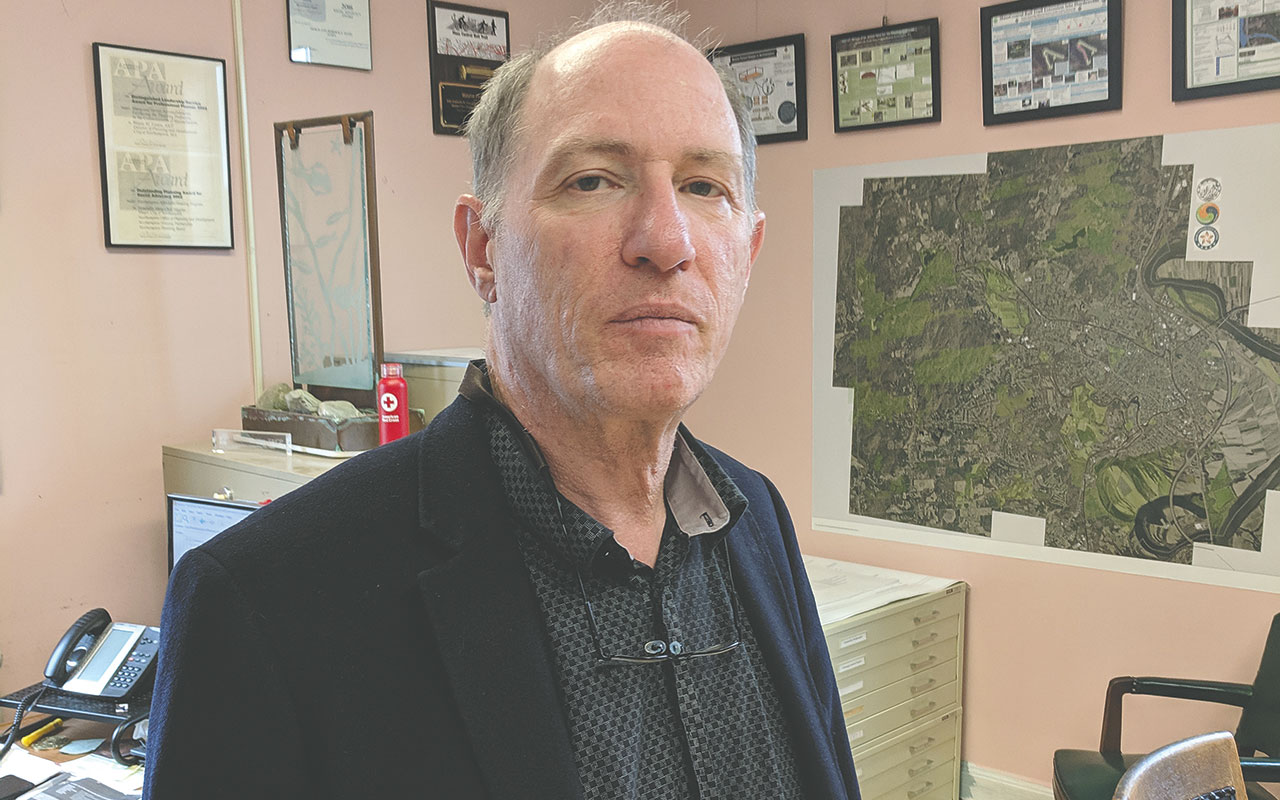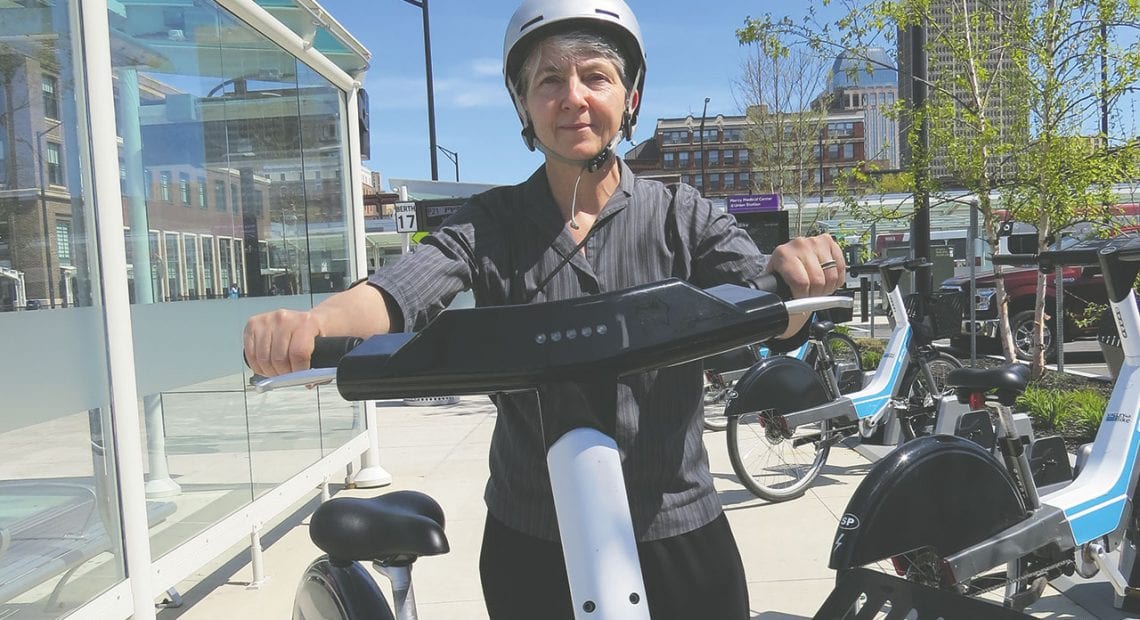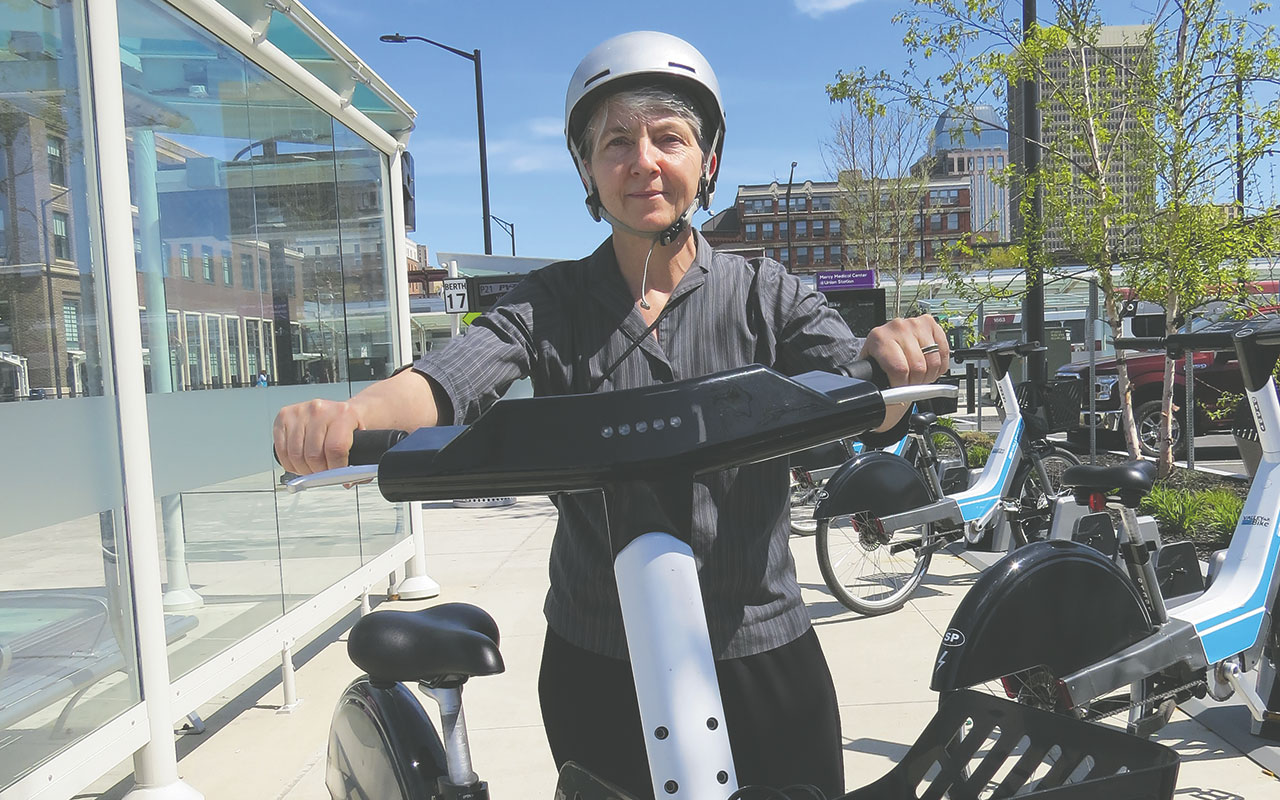Pedal Power
ValleyBike had, by most accounts, an up-and-down first year, and we’re not talking about the hills its bikes make a little easier through electric pedal assist. But on the whole, 2018 was an encouraging success, with gradually increasing ridership across the network’s six municipalities, despite a slow and incomplete roll-out of the 50 stations and 500 bikes. With further expansion possible, hopes are high that more people will ditch their cars for a bike ride in 2019 — and then turn that ride into a habit.
A regional bike-share program may have seemed like a novel idea for many Pioneer Valley denizens last year, but for those who helped bring it about, it’s far from a new concept.
“We’ve been talking about it in the Pioneer Valley for 15 years,” said Catherine Ratté, principal planner and Land Use & Environment section manager at the Pioneer Valley Planning Commission. In fact, the PVPC produced a report in 2008 documenting previous bike-share programs around the world — including the Yellow Bike program that once existed at Hampshire College as well as the Bixi Bikeshare program in Montreal — and encouraging Pioneer Valley municipalities to look into establishing a regional program.
A lot has happened since then, but the main development was the emergence of electric pedal-assist bikes that help riders navigate hills and long distances they might not have wanted to attempt before. It was a game changer, Ratté said.
“Part of it was being a broad region — how can people get from Amherst to Northampton to Springfield? Then electric pedal assist came along, and we said, ‘oh, this could be a regional program,’” she told BusinessWest.
That program, known as ValleyBike, currently encompasses six communities — Northampton, Amherst, Springfield, Holyoke, South Hadley, and Easthampton — with others possibly on the horizon. A rider is free to pick up a bike at any of the 50 stations and drop it off at any other.
“The idea is to replace car trips with bike trips, and pedal assist makes it easier for all ages and abilities to use,” said Ratté. “It’s a big piece of acting on the climate crisis, but we also have a public-health crisis, and people don’t always have the opportunity to be physically active. ValleyBike makes it easier for people to bike to work. Maybe they aren’t physically fit enough to bike without pedal assist, and they don’t want to arrive at work sweaty — but they’re still exercising.”
A recent PVPC report detailed use of ValleyBike during 2018, its inaugural year. Even with limited availability and a slow ramp-up of stations (more on that later), the service logged 26,353 trips last year, an average of 170 per day, generating 83,735 miles — the equivalent of 3.3 times around the earth.
With the numbers expected to increase in 2019, that represents a significant front in the battle against traffic and air pollution, said Wayne Feiden, Northampton’s director of Planning & Sustainability.
“Our biggest commitment this year is to get more people to say, ‘yes, I really want to use this,’” said Feiden, who has long been one of the region’s strongest proponents of a bike-share network. “Nationwide, about a third of the people using bike shares are coming out of their car — making what would have been a car trip otherwise. If we can get you out of your car, that’s great from an environmental standpoint and a congestion standpoint. And that’s the part we need to grow most in the system.”
According to the year-end rider survey that helped the PVPC generate its report, the vast majority of users — 77.9% — rode ValleyBike less than five times per month, and 2.8% used it daily, with another 2.8% riding five or more times per week. These figures suggest that many users rode the bikes for leisure rather than to commute, which isn’t necessarily a bad thing, Feiden said.

Wayne Feiden says ValleyBike organizers have several goals, from reducing traffic and air pollution to getting people more physically active.
“We have a lot of goals, and each one serves different purposes,” he noted. “One is just to get people to exercise more. So that’s been great, and it’s also been a diverse set of users.”
Indeed, 28.8% of survey respondents were between 18 and 30, 52.1% were between the ages of 30 and 60, and 6.9% were over 60 years old, while the gender split was close to even.
“People who use bikes tend to be younger, but these bikes are reaching a broader range of users, which is great,” he said. “Getting people healthier is wonderful, as is giving people transportation options, whether they can’t afford a car or don’t want to drive a car for environmental reasons.”
“The idea is to replace car trips with bike trips, and pedal assist makes it easier for all ages and abilities to use. It’s a big piece of acting on the climate crisis, but we also have a public-health crisis, and people don’t always have the opportunity to be physically active.”
One goal moving forward, he said, will be to increase usage of memberships. Annual passes ($80) accounted for just 13% of all rides in 2018, and monthly passes ($20) represented another 28%.
Those riders, Feiden said, are the ones more likely to use ValleyBike Share for commuting to work or other daily commitments, and to turn biking from a leisure activity into a habit and a lifestyle. “Once you sign up for a year, you tend to build your commitment.”
For this issue, BusinessWest looks at the ways ValleyBike is building on its own commitment — and its momentum, both electric-assisted and figuratively.
Winding Path
To its proponents at the PVPC, ValleyBike is a key component of the region’s path to a sustainable future by promoting healthy habits and reducing greenhouse gases emitted by vehicle trips. If managed effectively, the year-end report notes, the program could also reduce the need for road repairs and expansion, and has the potential to improve the effectiveness of the region’s transit system.
Following the 2008 report exploring the concept, UMass Amherst launched a free bike-sharing program in 2012 funded by student government fees. The same year, Northampton’s Planning and Sustainability Department began researching a program for that city.
Mayor David Narkewicz approved a single bike-share station downtown, but by early 2013, officials determined that a larger system, either city-wide or, better yet, region-wide, was preferable. At the same time, Amherst officials were meeting with representatives from Amherst College, Hampshire College, and UMass to explore a town-wide bike-sharing program.
Soon after, the PVPC secured a Massachusetts Clean Energy Center grant to work with several area communities to advance clean-energy strategies, selecting advancement of a regional bike-share initiative as a priority for funding.

The ValleyBike station at Court Square, one of 11 in Springfield, saw the sixth-most ride starts across the entire network in 2018.
Between 2014 and 2016, the PVPC worked with a group of member municipalities — Amherst, Holyoke, Northampton, and Springfield — to research and advance regional bike-sharing. In 2016, Northampton, with PVPC and regional support, applied for and obtained federal Congestion Mitigation and Air Quality funds for a regional bike-share network for four communities, later adding South Hadley as a fifth member.
A year later, Northampton, with PVPC and regional support, released a bike-share RFP and awarded a contract to Bewegen Technology for a 500-bike, 50-station system in the five communities. Toward the end of 2018, Easthampton obtained a Massachusetts Housing Choice grant for ValleyBike and joined the regional consortium, growing it to six municipalities.
The year-end report notes that ValleyBike had a rocky start due to issues with station installation, bike availability, and kiosk usability. Only 26 stations were open when the system went online on June 28, and another 17 were added in July and August. The remaining seven opened at the start of the 2019 season, bringing the total to 50.
After a slow start, the popularity of ValleyBike saw large increases in the first few weeks of August, reaching its peak ridership between Aug. 21 and Sept. 3, dipping slightly as temperatures dropped and students went back to school in early September.
“This is the first regional, multi-community, all-electric-pedal-assist bike-share program in the world. It was a really ambitious idea,” Ratté told BusinessWest. “It could have been smoother, but we had fantastic numbers of riders from all communities. And we definitely are eager to expand the coalition.”
She noted that possible expansion communities include Hadley, Chicopee, and West Springfield, should the PVPC secure the necessary additional funding. “We hope to keep it growing and expanding as well as adding some stations in the existing communities.”
“Nationwide, about a third of the people using bike shares are coming out of their car — making what would have been a car trip otherwise.”
With a longer season this year and more bikes — the network typically had about 167 available last year, but will offer 500 at the 50 stations in 2019 — she expects an uptick in ridership and increasing interest from the communities not yet on board.
“Hadley and Chicopee are the two holes in the system we’re trying to fill. We’re also trying to expand to West Springfield, but that’s more expanding out rather than filling in holes,” Feiden added. “Obviously we have to get more funding for new stations; there are many more locations that would make sense than we have money for.”
He added that more corporate sponsors are needed to make the system more sustainable. “But businesses are seeing the value for it — a third of the stations in Northampton are on private property. People gave us easements or licenses, whatever they needed to do, because they saw the value. One is at Cooper’s Corner in Florence, a small grocery store, and I hope people shop there because they gave us some really valuable real estate.”
Sustainable Future
Between climate concerns, public-health awareness, and simply enjoying the outdoors, bicycling — especially when pedal-assisted on those tricky hills — holds appeal to many demographic groups, Ratté said.
“If you ask people what they want in their region, a bike share is a popular thing. People expect their cities to fund options for getting around. And the cool thing is, you don’t have to stay inside your municipality; the same bike can go from place to place. It’s very convenient.”
That said, the program would benefit by coordinating more closely with public transit systems, she noted. According to the year-end survey, 27.5% of riders used ValleyBike in conjunction with other types of public transportation (such as rail or bus services). Organizers had hoped that bike stations could be located close to public transportation so public-transit riders could utilize the bikes to reach their final destinations. However, due to complications regarding the need for electrical outlets in close proximity to stations, this goal was not always met. That’s something planners are looking to remedy with future bike-station placements.
“People rely on the bus,” she said, “and to be able to use ValleyBike to get to and from the bus stop would be great.”
On a related note, the Community Foundation of Western Massachusetts worked with the Pioneer Valley Regional Ventures Center, the not-for-profit arm of the PVPC, to allocate $12,000 per year over three years to provide subsidized memberships for economically disadvantaged residents of the region, particularly those who live in transit-rich urban cores. Bewegen was not able to launch this aspect of the ValleyBike initiative in 2018, and more people are expected to use ValleyBike when the access passes become available this year.
So far, however, people seem to be using the bikes mostly for enjoyment. Of the year-end survey respondents, 52% said they used ValleyBike mostly for leisure, while 21.2% used them to commute, 5.5% wanted to reduce pollution and traffic congestion, and 5.2% were focused on the health benefits. Notably, 36% reported an increase in riding bikes of all kinds since using the system.
“In some ways, the biggest criticism is people asking, ‘why didn’t you come to my neighborhood?’” Feiden said, noting that Northampton added one stop this year and has applied for a grant to establish four more. “And that’s great. It’s nice to get beat up for not doing it.”
The hope is that the coming years will see fewer of those complaints as ValleyBike continues to expand, giving more people an excuse to leave their cars behind, get their legs moving, and maybe leave the air a little cleaner.
Joseph Bednar can be reached at [email protected]






